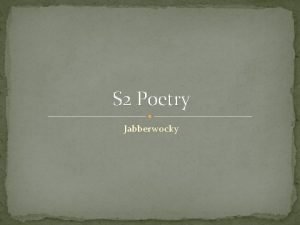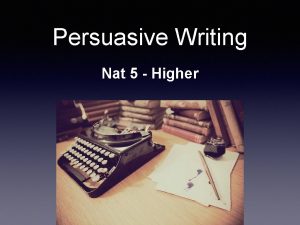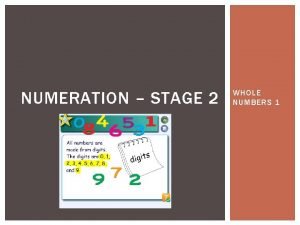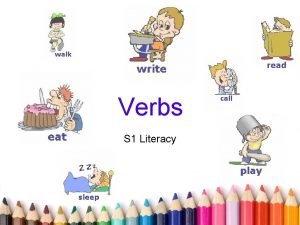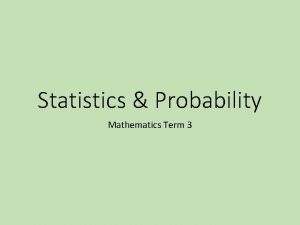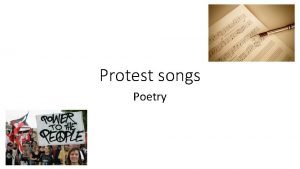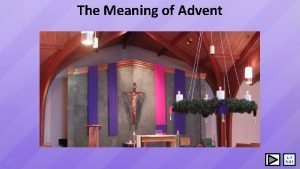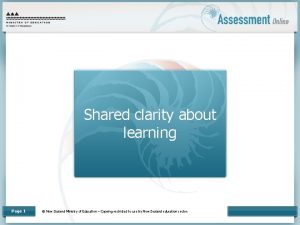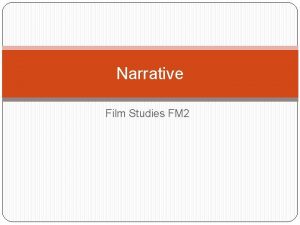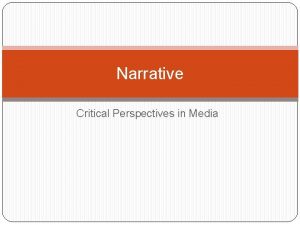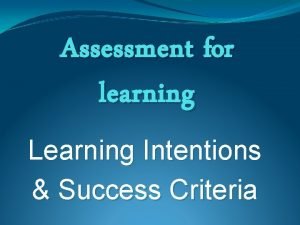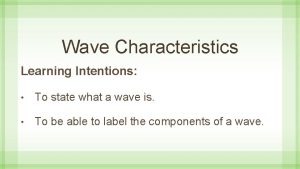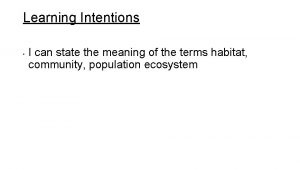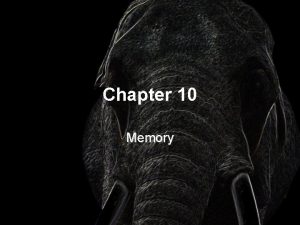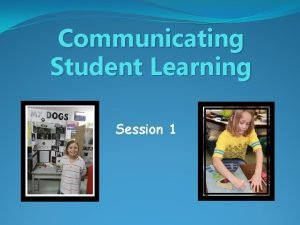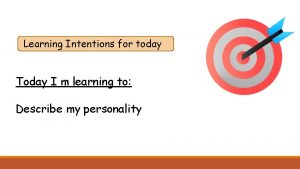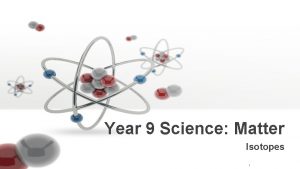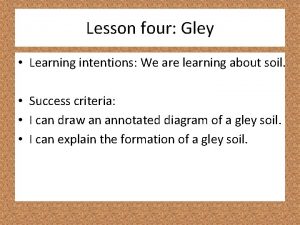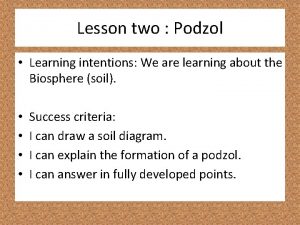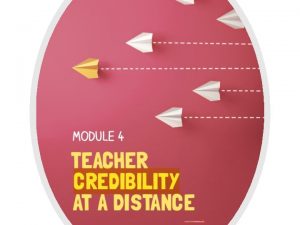Memory Learning Intentions 1 State that memory involves































- Slides: 31

Memory


Learning Intentions 1. State that memory involves storage, retrieval and retention and includes past experience, knowledge and thoughts. 2. Describe how information entering the brain reaches long term memory (LTM). 3. Describe the features of the sensory memory. 4. Describe the span of the short term memory (STM). 5. Explain the serial position effect. 6. Describe how STM can be improved or maintained by ‘chunking’ and ‘rehearsal’. 7. State the two ways in which information is lost from the STM. 8. Describe the methods which aid transfer of information into the LTM. 9. Define the term ‘encoding’ & describe the different methods of encoding. 10. Describe how contextual cues aid memory retrieval. 11. State the locations of episodic, semantic, procedural, emotional and spatial memories within the brain.

Memory • Memory is one of our mental faculties. Memory involves encoding, storage and retrieval of information. • Memories include past experiences, knowledge and thoughts.

• All information entering the brain passes through sensory memory and enters short term memory (STM). • Information is then either transferred to the long term memory (LTM) or is discarded.



Sensory Memory • Lasts a few seconds and retains all of the visual or auditory input. • Stimuli from the outside world are continuously being perceived as sensory images by the brain. • These images are very short lived between 0. 5 and 2 seconds. Only selected images and sounds are encoded into short-term memory.

Short Term Memory • Allows us to remember information for a few seconds before it is replaced by more. • Has limited capacity, or memory span, it can retain about 7 pieces of information for about 30 seconds

• Information in the STM must be passed into the LTM or it will be lost by • displacement, the ‘pushing out of old’ information by new information • decay, the breakdown of the ‘memory trace’.

More information can be retained in the STM if it is organised. Chunking can increase memory span by organising information of smaller units into a chunk e. g. telephone numbers can be chunked to give an area code which reduces 4 numbers to one piece of information— 0141 for Glasgow etc. 01416293901

Rehearsal involves repeating information to yourself many times. This extends the length of time the information is held in the STM and increases the chance that it will be transferred to the LTM.

• STM can also process data, to a limited extent, as well as store information. • This ‘working memory model’ explains why the STM can perform simple cognitive tasks.



Serial position effect is where the first few and last few items from a string of facts are remembered best. The first few items are remembered as there has been time to rehearse them and they have become encoded and transferred to the LTM. The last few are remembered because they are still in the STM. Items in the middle are displaced by the last items.



Long Term Memory • LTM has an unlimited capacity and holds information for a long time.

Successful transfer of information from the STM to LTM is promoted by rehearsal, organisation and elaboration of meaning. Rehearsal involves simple repeats or practices of information Shallow form of encoding


Organisation is where information is placed into logical groups or categories, in a way that is meaningful to the learner. List 1 List 2 cow jacket sheep tin chicken cat sheep jacket iron trousers shirt chicken tin shirt iron lead

Elaboration involves building more detail around the information (creating a ‘bigger story’) • For example, the name of a person is much more likely to be transferred to the LTM if it is associated with mental images, personality, experiences and smells, such as their perfume/aftershave. • Deeper form of encoding

Encoding In order for information to be transferred from the STM to the LTM, information must be encoded (converted to a form that the brain can process and store). The quality of the memory depends on the attention given to the encoding it. Information can be encoded using: • shallow encoding, such as repetition • elaborative encoding, such as linking with previous memories, which is considered

Encoding The quality of the memory depends on the attention given to the encoding it. Information can be encoded using: • shallow encoding, such as repetition • elaborative encoding, such as linking with previous memories, which is considered as a deeper form of encoding.

Retrieval • Contextual cues aid the retrieval of information from the LTM. • A contextual cue relates to the time and place when the information was intially encoded into the LTM


Questions and Answers 1. State what memory and what it includes Memory involves storage, retention and retrieval of past experience, knowledge or thoughts. 2. Describe how information entering the brain reaches long term memory (LTM). All information which enters the brain passes through sensory memory and enters the short term memory. Information can then be transferred to the long term memory (LTM).

3. Describe the features of the sensory memory. Sensory memory retains all visual and auditory input but for a very short period of time, only 1 or 2 seconds. 4. Describe the span of the short term memory (STM). It holds about seven items of information for roughly 30 seconds. 5. Explain the serial position effect. When information is viewed in a sequence, the first and last few pieces of information are remembered best.

6. Describe how STM can be improved or maintained Rehearsal or chunking 7. State the two ways in which information is lost from the STM. Displacement and Decay 8. Describe the methods which aid transfer of information into the LTM. Rehearsal, organisation, elaboration of meaning

9. Define the term ‘encoding’ & describe the different methods of encoding. converted to a form that the brain can process and store shallow encoding e. g. repetition elaborative encoding e. g. linking with previous memories 10. Describe how contextual cues aid memory retrieval. these are signals or reminders relating to the conditions which were present at the time the memory encoded into the LTM.
 Jabberwocky alliteration
Jabberwocky alliteration Learning intentions and success criteria examples
Learning intentions and success criteria examples Examples of learning intentions
Examples of learning intentions Learning intentions and success criteria examples
Learning intentions and success criteria examples Persuasive writing learning intentions
Persuasive writing learning intentions Write a number in expanded form. 637
Write a number in expanded form. 637 Basking shark poem analysis
Basking shark poem analysis The reciprocal of 3¾ is
The reciprocal of 3¾ is Half-turn symmetry
Half-turn symmetry Learning intention verbs
Learning intention verbs Poetry learning intentions
Poetry learning intentions Learning intentions and success criteria for mathematics
Learning intentions and success criteria for mathematics Poetry learning intentions
Poetry learning intentions Poem paragraph
Poem paragraph Creative writing learning intentions
Creative writing learning intentions Success acrostic
Success acrostic The crucible character map
The crucible character map Learning intentions meaning
Learning intentions meaning Shared clarity about learning intentions
Shared clarity about learning intentions Narrative learning intentions
Narrative learning intentions Act 2
Act 2 Dylan wiliam learning intentions
Dylan wiliam learning intentions Phân độ lown
Phân độ lown Block nhĩ thất độ 2 type 1
Block nhĩ thất độ 2 type 1 Thơ thất ngôn tứ tuyệt đường luật
Thơ thất ngôn tứ tuyệt đường luật Thơ thất ngôn tứ tuyệt đường luật
Thơ thất ngôn tứ tuyệt đường luật Walmart thất bại ở nhật
Walmart thất bại ở nhật Tìm vết của đường thẳng
Tìm vết của đường thẳng Con hãy đưa tay khi thấy người vấp ngã
Con hãy đưa tay khi thấy người vấp ngã Tôn thất thuyết là ai
Tôn thất thuyết là ai Gây tê cơ vuông thắt lưng
Gây tê cơ vuông thắt lưng Sau thất bại ở hồ điển triệt
Sau thất bại ở hồ điển triệt
